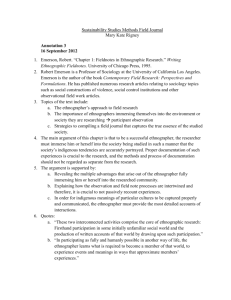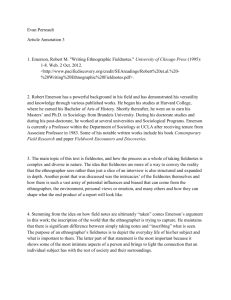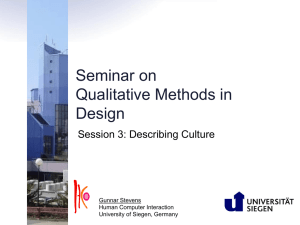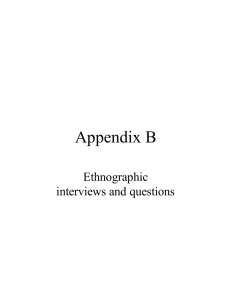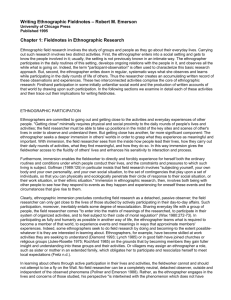Sustainability Studies Methods Field Journal Kasey Francica
advertisement
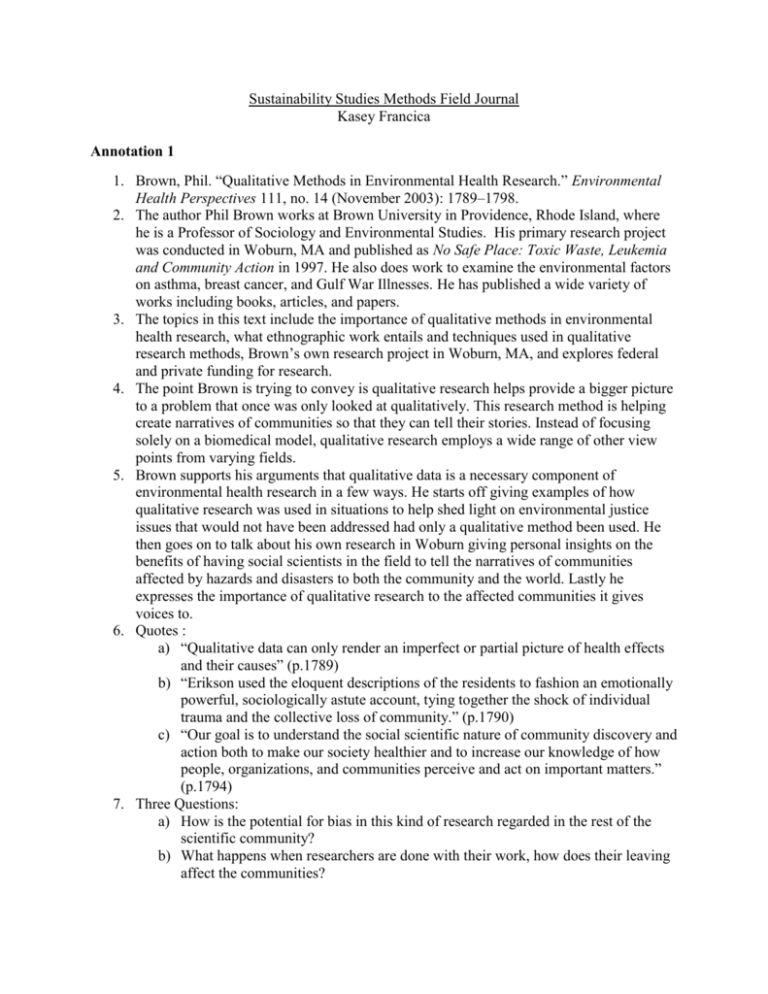
Sustainability Studies Methods Field Journal Kasey Francica Annotation 1 1. Brown, Phil. “Qualitative Methods in Environmental Health Research.” Environmental Health Perspectives 111, no. 14 (November 2003): 1789–1798. 2. The author Phil Brown works at Brown University in Providence, Rhode Island, where he is a Professor of Sociology and Environmental Studies. His primary research project was conducted in Woburn, MA and published as No Safe Place: Toxic Waste, Leukemia and Community Action in 1997. He also does work to examine the environmental factors on asthma, breast cancer, and Gulf War Illnesses. He has published a wide variety of works including books, articles, and papers. 3. The topics in this text include the importance of qualitative methods in environmental health research, what ethnographic work entails and techniques used in qualitative research methods, Brown’s own research project in Woburn, MA, and explores federal and private funding for research. 4. The point Brown is trying to convey is qualitative research helps provide a bigger picture to a problem that once was only looked at qualitatively. This research method is helping create narratives of communities so that they can tell their stories. Instead of focusing solely on a biomedical model, qualitative research employs a wide range of other view points from varying fields. 5. Brown supports his arguments that qualitative data is a necessary component of environmental health research in a few ways. He starts off giving examples of how qualitative research was used in situations to help shed light on environmental justice issues that would not have been addressed had only a qualitative method been used. He then goes on to talk about his own research in Woburn giving personal insights on the benefits of having social scientists in the field to tell the narratives of communities affected by hazards and disasters to both the community and the world. Lastly he expresses the importance of qualitative research to the affected communities it gives voices to. 6. Quotes : a) “Qualitative data can only render an imperfect or partial picture of health effects and their causes” (p.1789) b) “Erikson used the eloquent descriptions of the residents to fashion an emotionally powerful, sociologically astute account, tying together the shock of individual trauma and the collective loss of community.” (p.1790) c) “Our goal is to understand the social scientific nature of community discovery and action both to make our society healthier and to increase our knowledge of how people, organizations, and communities perceive and act on important matters.” (p.1794) 7. Three Questions: a) How is the potential for bias in this kind of research regarded in the rest of the scientific community? b) What happens when researchers are done with their work, how does their leaving affect the communities? c) What do researches do when they hit an extreme wall of resistance from communities when trying to do participant research? 8. Three points to follow up on: a) Examples of what happened to communities when no qualitative research was done to help address their health issues b) Expand on ethical issues that come up with bias c) Instances where communities had negative feedback regarding someone’s work Annotation 2 1. Mills, C. Wright. “On Intellectual Craftsmanship.” The Sociological Imagination. Oxford University Press. New York: 1959. 2. C. W. Mills was an American sociologist and was a professor at Columbia University from 1946 until he died in 1962. He is widely known for many of his works that included intellectual journals as well as some books. Milles work focused of the responsibilities intellects in post WWII society; he is known to have a significant impact of left social movements of the 1960s. 3. The topics of this text include Mills technique of improving his craft as a social scientist and researcher which is to keep personal files combining what you are experiencing intellectually as well as what you experience as a person. He then goes on to talk about the methodology of using your journal to organize and build your thoughts into a bigger well thought out study. 4. The main argument of this reading is that his unique approach of training yourself to take meticulous personal notes leads to the production of valuable research. This method constantly makes you think and then re-think your feelings and ideas so the end product is well thought out and objective. 5. Mills supports his argument buy explaining the importance of each step of his process in maintaining a balance between the flow of ideas and order and comprehensiveness. He states that by keeping a journal you are constantly working on a project and you will always have ideas you want to further expend. When you do choose a subject to work on you will have an entire file of thoughts, conversations, and research to work off of. The next step is to focus in and try and organize, you begin to look for patterns resulting in a more expansive thought process. His last point is in the end you must learn how to write clear and simply as the subject matter will permit. 6. Quotes: a) “You will have often noticed how carefully accomplished thinkers treat their own minds, how closely they observe their development and organize their experience.” b) “For once you lay out an empirical study, even if you don’t follow through, it leads you to a search for data, which often turn out to have unexpected relevance to your problem.” c) “It is the imagination, of course, that sets off the social scientist from the mere technician.” 7. Three Questions: a) How often does he sort through his files in attempts to keep them organized? b) How does this method apply to more specialized fields that narrow in on specific social structures? c) What if a project has taken up an exceedingly long time, at what point do you move on? 8. Three points to follow up on: a) What is the best way to keep an everyday field journal b) The commonality of the use of his method of life experience mixed with intellectual work c) Research academics that have a tendency to write unintelligibly Annotation 3 1. Emerson, Robert. “Chapter 1: Fieldnotes in Ethnographic Research.” Writing Ethnographic Fieldnotes. University of Chicago Press, 1995. 2. Robert Emerson is a Professor of sociology at the University of California Los Angeles. Some of his most notable works include his book Contemporary Field Research and paper Fieldwork Encounters and Discoveries. 3. Topics included in text: a) How a ethnographer should approach immersion and the importance of participant observation b) Problems that can arise due to immersion c) Strategies for taking descriptive field notes 4. The main argument of this chapter is that an ethnographer has two distinctive undertakings to take on when in the field: to be able to immerse themselves into a group and actively participate as well as properly (descriptively) documenting observations while trying to eliminate the potential for bias. 5. Support of the argument: a) He explains how the process of immersion helps build trust and acceptance of the group advancing their ability to learn as much as possible about the group b) He explains that field notes cannot just be copied down facts about what happened but the field needs to actively interpret and make sense out of even the smallest things. c) He goes on to point out field notes are written how the fieldworker perceives things not necessarily how they happened. He explains the separation of methods and substance in order to recognize that findings are not absolute. 6. Quotes: a) “The ethnographer seeks a deeper immersion in others’ worlds in order to grasp what they experience as meaningful and important.” b) “But in fact there is no one “natural” or “correct” way to write about what one observes.” c) “Ethnography is an active enterprise. Its activity incorporates dual impulses. 7. Three Questions: a) How exactly can you determine definitively if observations in field notes are as objective as possible, it still seems possible that a fieldworker can portray his/her basis in field notes? b) If a fieldworker was asked to partake in an indigenous activity that made them uncomfortable, how exactly do they decline without losing the trust of the group? c) When is it acceptable to update your field notes? At what point does it make the community uncomfortable? 8. Three follow up points: a) Look up different studies done on the same community b) Look up the best way to compile and organize your notes c) Look up extremes, someone who didn’t get close enough and someone who got too close Annotation 4 1. Cronon, W. (1992). A Place for Stories: Nature, History, and Narrative. The Journal of American History,78(4), 1347-1376. 2. William Cronon is a Professor at the University of Wisconsin-Madison he is a Professor in history, geology, and environmental studies as well as the director for culture, history and environment. He is an expert on the history of environment conservation and environmentalism in the U.S. west, frontier, public wetlands and in Wisconsin. 3. In this text Cronon presents a chronicle listing of events that happened in environmental history in the Great Plains; he discusses the difficulties historians have with narratives, the new deals impact on such narratives, and then goes on to talk about different narratives of the same time have different viewpoints. 4. His main argument is the importance of narrative stories of environmental history because they shape the moral framework. He argues that having an expansive narrative can help frame a broader history to help fully understand the things that have impacted different ecosystems. 5. He supports his argument by discussing how having different narrative interpretations of history of the same place is problematic because these narratives do not necessarily tall the same story. He then goes on to give examples of different stories told by different sources and compares them. In the end he tries to demonstrate that a historical narrative can be descriptive and interesting as well as fitting different interpretations of the events into a single story. 6. Quotes: d) “A powerful narrative reconstructs common sense to make the contingent seem determined and the artificial seem natural.” e) “The political subtext of this story is not hard to find. Whereas the heroes of earlier Great Plains narratives had been the courageous and inventive people who settled the region, the New Dealers constructed their stories so as to place themselves on center stage.” f) “As Aristotle reminded us so long ago, narrative is among our most powerful ways of encountering the world, judging our actions within it, and learning to care about its many meanings.” 7. Three Questions: d) Is the author actually being objective in his story telling, he stated in the beginning of the article he chooses what events are most important? e) Is the author suggesting all historians working on one particular area work together to create one narrative history? f) What historical events does he believe have been the most misrepresented? 8. Three follow up points: d) narratives of other events in environmental history e) possibilities of biases in narrative historical documentation compared to factual f) possibility of collaboration and multiple sources in historical documentation Annotation 5 1. Emerson, Robert. “Chapter 2: In the Field: Participating, Observing, and Jotting Notes.” Writing Ethnographic Fieldnotes. University of Chicago Press, 1995. 2. Robert Emerson is a Professor of sociology at the University of California Los Angeles. Some of his most notable works include his book Contemporary Field Research and paper Fieldwork Encounters and Discoveries. 3. The main topics of this text are the two styles of participation, knowing when and how to effectively take field notes, and how to combine the two and become an effective observer. 4. The main argument of this text is that every field worker is different and their different styles of note taking and participation will vary as well, however every field worker needs a strategy to allow them to be able to fully participate without effecting the quality of their notes 5. Emerson argues his point by presenting examples of situations where field workers had participants had uncomfortable exchanges in the presents of an ethnographer taking notes. He also gives examples and analyzes them and then goes into a step by step method of how to effectively take field notes. 6. Quotes : a) “Although taking down jotting may feel odd or awkward, after time it often becomes a normal and expected part of what the field worker does.” b) “When deciding when and where to jot, it is rarely helpful or possible to specify in advance the “best way.” c) “While the primary goal of ethnography is immersion in the life-worlds and everyday experiences of a group of people, the ethnographer inevitably remains in significant ways an outsider to the worlds of those studied.” 7. Three Questions: a) Are there strategies used more often than others? b) What do you do in a situation where a participant seems overly offended by your note taking? c) If you are in a situation where you can only take notes at night how does that affect the quality of your research? 8. Three points to follow up on: a) Examples of pages from a researchers field notes b) Find a research project done with poor observation technique c) How I could attempt these strategies to observe my own family Annotation 6 1. Emerson, Robert. “Chapter 6: Processing Fieldnotes: Coding and Memoing.” Writing Ethnographic Fieldnotes. University of Chicago Press, 1995. 2. Robert Emerson is a Professor of sociology at the University of California Los Angeles. Some of his most notable works include his book Contemporary Field Research and paper Fieldwork Encounters and Discoveries. 3. The main topics of this text develop how to approach analyzing feildnotes. It touches upon techniques of closed reading, open coding, and witting initial memos. 4. The main argument of this text is that through the methods of reading, coding, and memoing an ethnographer can better analyze their data that will help identify key issues and possibilities to expand upon. 5. Emerson argues his point by explaining the methods of reading, coding, and memoing and explains the benefits it will have to your further research. He touches on how fieldnote taking is only the initial process the ability to assemble and process the information is what will get you to a grounded theory. 6. Quotes : a) “To undertake an analytically motivated reading of one’s fieldnotes requires the ethnographer to approach her notes as if they had been written by a stranger.” b) “The secret of coding lies in turning the answers to these questions into a distinctive kind of writing-a word or short phrase that captures and signals what is going on in a piece of data in a way that links it to some more general analytic issue.” c) “By breaking down field notes even more finely into subcodes, the ethnographer discovers new themes and topics and new relationships between them.” 7. Three Questions: a) Are there other strategies to analyzing field notes? b) When sharing information with others which form would you use? c) What do you do if you struggle to generalize you data into specific subtopics? 8. Three points to follow up on: a) Examples of pages from a researchers field notes b) What the next step is c) Other types of coding methods
